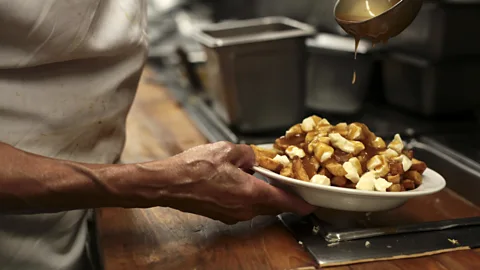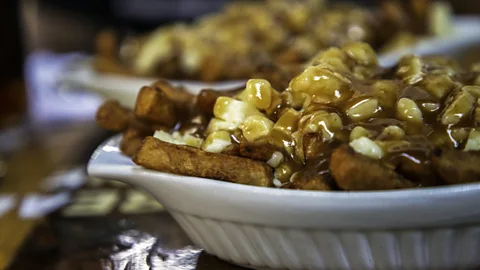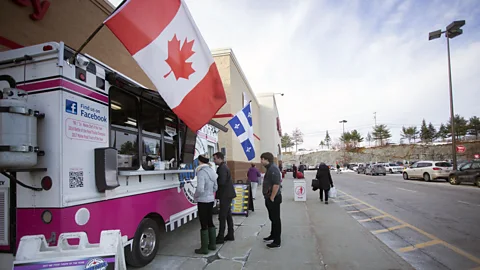Why only Quebec can claim poutine
 spasmik/Getty Images
spasmik/Getty ImagesPolitical tensions are never far from the surface in this Canadian province, even when it comes to this beloved snack of French fries, cheese curds and gravy.
"It is the unofficial official dish of Canada. In fact, if they could make it look good on a flag, the maple leaf's days might be numbered," Jamie Oliver quipped in an article about making the perfect poutine. As harmless as Oliver's comment appears, it's the perfect example of how a dish that stirs real feelings of heritage and culture in the Canadian province of Quebec may slowly be losing its regional identity.
Whether it's from a busy late-night diner or a quiet countryside cafe, poutine's combination of French fries topped with fresh salty cheese curds and a rich meaty gravy remains a simple, timeless comfort food. Though its unassuming origins lie in the rural dairy strongholds of the Centre-du-Québec region, the popularity of the dish spread to Montreal's cafes and bistros in the 1970s, hit the menus of fast-food giants like Burger King and McDonalds a decade later, and was a nationwide favourite by the early 1990s.
 JML Images/Getty Images
JML Images/Getty ImagesBut tensions around identity are never far from the surface in Canada's only French-speaking province, even when it comes to its most beloved culinary export. From chain restaurants across Canada to street food trucks in Europe and Asia, poutine has travelled far. But rather than the Quebecois fleurdelisé flag, it's the Canadian maple leaf symbol that appears most regularly on menus alongside the dish beyond the province's borders.
It's not only the iconography that confuses its identity. In 2016, US President Barack Obama served Canadian Prime Minister Justin Trudeau poutine at the White House because "we want our Canadian friends to feel at home". Venerable Canadian magazine Maclean's went as far as crowning poutine the country's most iconic dish in a 2017 survey. Whether it's through bold images or carelessly spoken words, the dish's regional heritage is often obscured.
My own first taste of poutine came from the hands of an overworked man helming a food truck amid the relentless hum of downtown Toronto's lunchtime rush. A sweltering summer afternoon in Canada's largest financial district is neither the time nor the place for poutine, but the rich melted cheese and tender yet springy texture left me yearning for more. But I also longed to try the dish in its home province, and some months later found myself braving Montreal's chilly autumn winds on my way to La Banquise, the city's poutine institution.
I pored over the lengthy menu, a 30-strong smorgasbord of deliriously comforting delights. I chose La Savoyarde, a gratuitous mountain of the standard poutine combo generously topped with bacon and onions, plus Swiss cheese and sour cream that began slowly melting the moment it was presented. This was poutine in its most flamboyant form; shamelessly indulgent and profoundly satisfying.
 Portland Press Herald/Getty Images
Portland Press Herald/Getty ImagesBut while I revelled in sampling the dish in one of its spiritual homes, my thoughts drifted back to the poutine sellers I'd seen back in Toronto, spots that largely ignored the Quebecois roots of the regional snack food. I wondered if even this humble comfort food couldn't be spared the identity tensions that have dogged Canada for decades. Though some time had ed since the nail-bitingly close sovereignty referendum of 1995, the linguistic and cultural divide between Anglo and French-speaking Canada remains. Many Quebecois don't feel strongly about their Canadian identity, fearing they are always at risk of cultural absorption.
“The dish should be, ideally, labelled explicitly as a Quebecois dish and not a Canadian one to further underscore the cultural context to which it actually belongs,” wrote Nicolas Fabien-Ouellet in his notable 2016 thesis, Poutine Dynamics.
You may also be interested in:
• Canada's Christmas tree in a bottle
And for some, any appropriation is to the detriment of Canadian gastronomy as a whole. "We are diluting Canadian cuisine if we say that regional dishes are national," said Quebec-based writer and restaurant critic Lesley Chesterman. "It's more interesting to say that a dish is Quebecois than to say that it is Canadian. Why not put the 'Quebecois' label on something that is Quebecois">window._taboola = window._taboola || []; _taboola.push({ mode: 'alternating-thumbnails-a', container: 'taboola-below-article', placement: 'Below Article', target_type: 'mix' });
